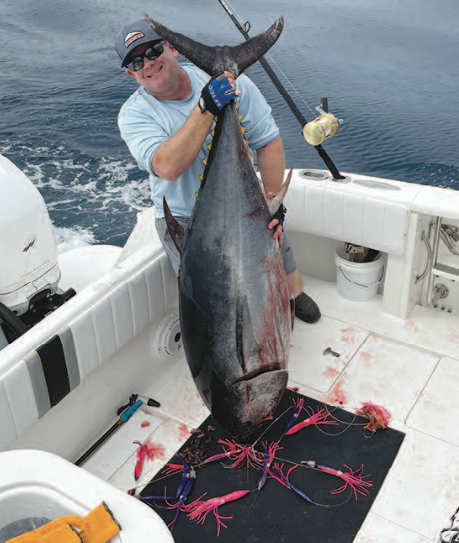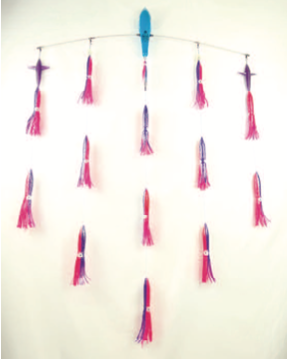
BY ETHAN SCHAFFER
The bluefin tuna fishery in Southern California, over the last five seasons, has been nothing short of legendary. Here we are in 2022, several seasons into the most in- credible tuna fishing Southern California has ever been a part of.
During the last several seasons, scores of anglers have had the opportunity to land their own personal bluefin tuna. While there are many successful days on the water, most of the time getting these bluefin tuna to bite on any given day can test even the most experienced and patient angler. Having a wide selection of tools at your disposal is the best chance to ensure success.
One very successful tool, the tuna spreader bar, has been around for many years on the East Coast but has just recently caught on like the plague here in Southern California. I first began using spreader bars and daisy chains in 2010 on a trip to Panama. It wasn’t until a couple of seasons back that I had the opportunity to see their pro- found success here locally.
What began as a hobby has now transformed into Odyssea Tackle Company – a full-time local business building custom spreader bars and daisy chains. I am pleased to share a few tips on what this tool is and how you can use it to improve your chances of success when fishing our local SoCal waters for bluefin tuna.
What is a spreader bar?
The spreader bar consists of a small diameter bar that typically ranges from 18-48 inches in length. The bar is made of vari- ous materials but most commonly steel or titanium. Attached to the bar are several teasers on separate lines that, when pulled along in the water resemble a small school of bait fish.

There are many styles of spreader bars on the market today, ranging from small 12-inch bars that utilize micro teasers to 48- inch bars with 15-inch teasers. When targeting local SoCal bluefin, the most popular bar has been a 36-inch titanium bar with 13 teasers, ranging from 9 to 13 inches each in length, and a few splash birds for the center and sides.
There is only one hook on the entire lure that is attached to the “chase bait” or “stinger”. This particular teaser is the last one on the main line. The chase bait is attached via a heavy snap swivel and hangs about 3 feet behind the rest of the teasers, giving the illusion that it is an injured baitfish or a smaller predatory fish chasing the school – something bluefin tuna can’t seem to resist.
A spreader bar is a versatile tool – it can be used while covering ground in search of fish, look- ing for bird activity, and in a wide variety of sea conditions. One of the most attractive aspects of this tool is that it does not demand a high level of skill to drag behind the boat and offers even the novice angler that follows a simple set of guidelines, the chance of catching a trophy.
Tackle is essential – be prepared!
The saying goes, “taking a knife to a gunfight is asking for trouble”. Bluefin are very good at finding the weak spot in tackle and making anglers pay with heartbreak. Having the right tackle for the job is critical.
As mentioned before, there are many sizes of spreader bars to choose from. Because of its size, the spreader bar causes a significant amount of drag in the water resulting in pressure on the tackle when compared to trolling single lures. When choosing the correct tackle, a few things to consider are:
1) Size and weight of the bar being used
2) Size of the fish being targeted
3) Trolling distance, and 4) Speed.
When a fish is hooked, the combination of the weight of the bar and fish must be considered to avoid tackle failure. Assuming we are fishing for local bluefin ranging in size
from 30 to 250 pounds, here are some suggestions.
Generally, for the larger spreaders in the range of 36 to 48 inches using 9- to 13- inch teasers, a 50-size class conventional reel with at least 130-pound line is recommended. For smaller size bars in the 18-24 inches range that utilize smaller, lighter weight teasers, a 20-30 size class reel with 80- to 100-pound line is recommended.
Trolling speed – they like the chase!
Speed is very important when fishing the spreader bar. You want to go at an ideal troll speed to cause enough splash and commotion to attract fish and get that bite. Too fast and it may not look natural, too slow and the fish may have enough time to second guess that bite.
The titanium bar at the right speed causes the teasers to bounce and pulsate in the water as it flexes. Every day is different, and the fish react differently. The important thing with speed is to make adjustments based on the conditions. Generally, the best trolling speed on calm days is between 7 to 9 knots, on bumpier days, troll a bit slower, 5 to 6 knots.
Captain Bryan Zulka of El Gato Dos Charters fishing out of Seaforth Landing has had a successful year thus far fishing the spreader bars, landing several fish over the 150-pound mark. Ac- cording to Captain Bryan, “Finding the right speed and distance for the bar is crucial to getting consistent bites. On El Gato Dos, we have found that 8.3 knots is ideal for the bars”. Don’t be afraid to change your speed, zig-zag, and turn frequently when you meter fish – many of our bites come on the turns.
Lure color – does it really matter?
There are many theories on whether color is important when choosing a lure. Many seasoned anglers claim that color is not im- important. Others believe that certain colors are essential in certain conditions.
For example, light lures on light days and dark lures on overcast or dark days should be used. In low light conditions, fish rely on cone cells in their eyes to detect contrast and motion rather than color. But in high light conditions, fish eyesight has been compared to that of humans. It is important to “match the hatch”, a term widely used to determine the type of bait that the fish are targeting and matching this with your lure presentation.
In addition, when it comes to choosing a color for your spreader bar, I recommend bright colors like pink/purple or tomato when the water is very clear, and the sun is shining. When the water is green or slightly off color and there is low light, the darker or natural hues seem to work better such as green mackerel, pink/ black, purple, or natural with aqua scales.
Don’t forget about the chase bait! Remember that the chase bait is the only part of the lure that has a hook and is almost always the one targeted. At Odyssea Tackle Company, we utilize a heavy-duty snap swivel at the end of the main center line that at- taches the chase bait. This system allows the angler to change out the chase bait and adjust the color instead of changing the entire spreader bar.
When purchasing a spreader bar, be sure to buy one that allows you to change out chase baits and be sure to buy yourself a few different colors rigged with fluoro- carbon. We use Aftco Seiko 300- pound for our standard chase baits, but offer several different line ratings. Some great colors in our local waters this season have been the lime glow, chartreuse, and green/orange/yellow.
Distance – farther than you think!
Generally, a traditional trolling spread would be set between 15 and 75 yards, with some exceptions. With bluefin, we have found that a bit farther distance is usually required as they are much more boat shy. Assuming I am fishing on a smaller vessel without outriggers, I keep it simple.
Spreader bars do not swing over and under as well as single lures because of their large surface area on the water and the increased distance they are typically pulled here on the West Coast. Because of this, it’s important to widen the spread to avoid tangles by utilizing the rod holders that provide the widest spread or using a wide tracking spreader bar. A wide track- ing bar has an angled keel that al- lows the bar to troll to one side resulting in a wider spread without the need for outriggers.
For a single bar, a good place to start is between 100 to 150 yards. The wide tracking bars can be much closer, at 50 to 75 yards. I can adjust the bars depending on the conditions. Captain Bryan’s method is simple but very effective. He mentioned, “We run them about 300-inch behind the boat, but often the weather depicts where we can place the bar. In rougher weather, we tend to run it closer to the boat. In calm seas, you have more flexibility in placement.
We’ve also learned that a single bar works for us, that way there is no way of it getting tangled with another bar or trolling lure. We do get blind strikes on the bar, but it seems most effective when we drag it by splashing fish or in an area where we are seeing jumpers and obvious activity”.
There are hundreds of variations and pattern choices when trolling a spread. Some boats prefer multiple lines with outriggers. The best thing to do is to keep your spread simple when first fishing the spreader bar and once you become comfortable continue to make adaptations based on the conditions.
Ethan Schaffer is a lifelong SoCal fisherman who started Odyssea Tackle Company to pursue his passion for everything fishing-related professionally.
If you have any questions or need assistance with any of your spreader bar or daisy chain needs, which are all built in Southern California and cover a wide range of boat sizes and budgets, visit his website or email: www.odysseatackleco.com odysseatackleco@gmail.com



